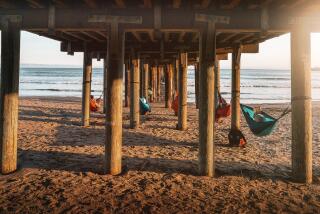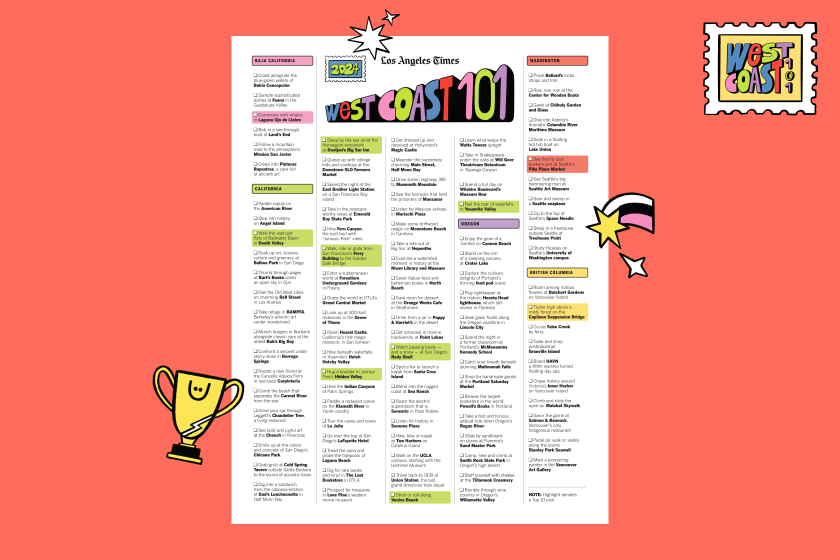ALMOST-FREE FALLIN’ : Our Candidates for Frugal Autumn Fun Include Canoe Trips, Foliage Tours and More
The gloomy figures keep rolling in: Not only are lots of people out of work, but the people who still have jobs are continuing to play it safe, displaying their limited confidence in the economy by spending less money.
Having fun on a reduced budget is not the biggest problem in this election year, but it can be a challenge. Orange County has more than its share of amusements, but many are geared to tourists spending their vacation savings and can be more than a little on the expensive side for the working stiffs who live here.
The cliche says the best things in life are free, and that can be true: playing in the waves off Huntington Beach, a walk along a sycamore-lined canyon, a romantic picnic in the park.
We call this semi-regular feature of O.C. Live! Cheap Thrills, and although it makes a nice headline, we should say that we could be exaggerating a tiny bit. “Thrills” may be a bit of an overstatement--nothing death-defying here--but the point is to suggest some creative and cheap ($10 or under) ways to spend a day in Orange County.
CANOEING THE BAY Most folks who visit Upper Newport Bay see only the edges, along Back Bay Drive or the bikes-only path that cuts across one corner of the estuary. A more complete view of the 752-acre wetlands reserve is possible, however, for people willing to put a bit of physical effort into the visit.
From a canoe or kayak, the back bay takes on a new perspective. The craft glide quietly upon the deeper waters of the estuary, where the ducks and grebes and scoters drift contentedly. Visitors also skirt the stands of cordgrass and mud flats that are the source of food for thousands of shorebirds that make the wetlands their home for the winter.
More than 100 bird species use the reserve, the largest remaining coastal wetlands in Southern California. The estuary also serves as nursery to dozens of fish species. Much of Upper Newport Bay is open to small craft moving less than 5 m.p.h., and kayaks and canoes are a common sight (the back portion of the bay is closed to all craft because it contains most of the easily disturbed nesting sites).
For people who don’t own their own boats, canoe tours of the bay are offered weekly by the state Fish and Game Department, which operates a number of nature-related activities at the reserve as part of the California Wildlands Program. Visitors guide their own canoes (two people per craft) on the leisurely tours, which are led by volunteer naturalists. No paddling experience is required.
The tours, which leave each Saturday at 9 a.m. from Shellmaker Island off Back Bay Drive, are open only to members of the California Wildlife Campaign. Membership is $11, but then all activities, including future canoe tours, are free. The tours are very popular, so reservations are required: call (714) 640-6746.
Kayak tours of the bay are offered by the Newport Dunes Resort, also on Back Bay Drive in Newport Beach. The tours are offered each Sunday at 10 a.m. and cost $10 per person. For information, call (714) 729-3863.
DISCOVERING A DANDY ZOO Orange County is not famous for its zoos, what with the world famous San Diego Zoo just a couple of hours south and the Los Angeles Zoo a little ways north.
But as small-town zoos go, the Santa Ana Zoo is pretty dandy, most notably for Monkey Row, a primate collection that includes some rare and endangered species. There’s easily a lunch-hour’s amusement in Monkey Row alone, and there are plenty of other creatures too.
One zoo that county residents may not be so familiar with is the Orange County Zoo in Irvine Regional Park. It’s more modest in scope--not much in the way of exotica--but its emphasis on wildlife of Southern California makes it an ideal place for kids (and grown-ups) to get a close-up look at local critters.
The zoo who’s who would include: wolf, coyote, raccoon, sable ferret, red fox, gray fox, coatimundi, mule deer, peccary, opossum, various owls and other birds of prey, raven, road runner, gull, brown pelican, duck, chicken and Canada goose.
The coatimundi, in case you are wondering, is a South American tree-dwelling mammal that resembles a raccoon. Most of the other critters are relatively local. A children’s petting zoo includes goats and sheep.
Irvine Regional Park, which just celebrated its 95th birthday last weekend, is the oldest regional park in the county. It has managed to remain a pleasantly old-fashioned kind of park: tree-filled, with a couple of small lakes, plenty of picnic areas, softball fields, pony rides and rentals of boats, bikes and horses.
The zoo got its start in 1920, when a Tustin rancher donated a pair of deer to the park. It evolved slowly over the years until 1983, when the old zoo was bulldozed and the new facility built. It continues to be upgraded and features relatively large enclosures designed to resemble the creatures’ natural habitats.
There are even a couple of minor celebrities. Last year, a family of foxes was discovered to have taken up residence along a newly built stretch of the Costa Mesa (57) Freeway. The foxes were captured and moved after a headline-making public outcry, and two of the animals eventually made it to the Orange County Zoo.
The zoo is open daily from 10 a.m. to 4 p.m. Park admission is $2, and there is no additional charge for the zoo. Irvine Regional Park is at 21401 Chapman Ave., Orange. Information: (714) 834-2400.
PERUSING KNOTT’S “Cheap” is an adjective not often used in connection with the area’s amusement parks, where adult admission is drifting toward the $30 mark, plus food, souvenirs and other extras. Locals in need of a little theme park ambience without the cost have a couple of options, however.
The last time we did one of these stories, we talked about the Disneyland Hotel, which features some Disney-styled shops, restaurants and modest attractions. Over at Knott’s Berry Farm, meanwhile, a shopping village and the local landmark Independence Hall replica are outside the park’s main gate--and Knott’s even provides free parking.
In the early ‘60s, park founder and patriotic guy Walter Knott and his family commissioned the building of an exact replica of Independence Hall in Philadelphia, where the Declaration of Independence was signed and the Constitution drawn up. Completed in 1966, the Knott’s replica features a copy of the Liberty Bell, historical displays, a 300-seat theater used for a slide show on the Declaration of Independence and a gift shop that sells facsimiles of historical documents and other bric-a-brac.
The centerpiece of the California Marketplace shopping village is Mrs. Knott’s Chicken Dinner Restaurant, which has been a Southern California landmark since the 1930s. The marketplace’s other longtime institution is Virginia’s Gift Shop, which started as a card table hawking souvenirs to folks waiting in line for the chicken dinners (the shop offers everything from jewelry and collector plates to, no kidding, stuffed Disney characters).
In all, the marketplace has more than 20 restaurants, food stores and other retail shops, including the Boots and Moccasins store, Bob’s Men’s Shop (there since the ‘40s), an international gift shop, an old-fashioned candy shop and a bakery. Takeout versions of the chicken dinners are also sold.
Free two-hour parking slots are along the park’s main entrance road, on Grand Avenue off Beach Boulevard. There is also a lot allowing up to three hours of free parking. The California Marketplace is open daily from 10 a.m. to 9 p.m. (the Chicken Dinner Restaurant opens at 7 a.m. for breakfast). To reach Independence Hall, cross through the pedestrian tunnel (away from the main park) and follow the signs. Hours are 10 a.m. to 5 p.m. daily.
The park is at 8039 Beach Blvd., Buena Park. For information, call (714) 827-1776.
LEARNING ASTRONOMY Planet Hollywood isn’t open yet, but every Sunday the stars make a midday appearance in Santa Ana.
The Tessman Planetarium on the campus of Rancho Santiago College has been used mostly as a teaching tool since the school ended public shows there in the ‘70s. But in 1990, Orange County Astronomers (a local stargazing club) offered to start giving public planetarium shows, which they do every Sunday at 2 p.m.
Topics change each month. This month, the subject is telescopes, with a history of the instrument from Galileo to the orbiting space telescopes of today, plus a bit of advice on how to buy a first telescope.
And of course, there will be projected views of the night sky, including depictions of how the sky looked in Galileo’s day. If you’ve never been to a planetarium, the effect is magical; the lights go off and the stars come out on the domed ceiling, without the distractions of smog or city lights. Despite the modest size of the Tessman dome (the sky is shown at one-fifth scale) the rendition of the sky is uncannily realistic.
For budding astronomers, the planetarium is a good place to get an introduction to the stars and pick up information on other club activities. Orange County Astronomers maintains an observatory site in Anza, in the desert of Riverside County, and in Orange County holds regular “star parties” in Silverado Canyon and monthly lectures at Chapman College.
The club, with help from the county, is also planning to someday open a public observatory in Santa Ana. Planetarium shows are $2. Rancho Santiago College is at 17th and Bristol streets in Santa Ana. Information: (714) 549-4963.
RIDING THE RAILS Most of the time, the Amtrak San Diegan roars by San Clemente Pier as it makes its way along the coast. On two of its southbound morning runs, however, it stops right at the foot of the pier, and it stops there again on a northbound run in the afternoon.
The round-trip fare from Santa Ana is $10, making this a good way to combine a train ride with a trip to the beach. The San Clemente Pier is a picturesque wooden structure that is home to hundreds of pigeons. The view is spectacular as the coastline curves north to Dana Point.
Located on the land’s end of the pier are a fairly upscale bar and restaurant; at the far end is a combination snack, coffee and tackle shack that is a favorite hangout for the locals. Most of the city within walking distance of the pier is residential. The beaches themselves, largely inaccessible to cars in either direction, are ideal for long walks.
Bring a good book and maybe a beach chair, because if you take the train it will be a long day. The second morning train leaves Santa Ana at 8:41 a.m. and arrives in San Clemente at 9:14 a.m. The same train departs Fullerton at 8:23 a.m. ($15 round trip) and Anaheim at 8:33 a.m. ($13 round trip). If you want to get going really early, the first train leaves Fullerton, Anaheim and Santa Ana at 6:44, 6:53 and 7:03 a.m., respectively.
The only northbound train leaves San Clemente at 3:56 p.m. and stops at Santa Ana, Anaheim and Fullerton. The current timetable is valid through Oct. 24; for information, call (800) 872-7245.
FALLING FOR FOLIAGE OK, so Orange County is no rival to New England when it comes to autumn color, but the old myth that Southern California has no seasons isn’t quite true either. The leaves on the county’s most common native tree, the California live oak, stay green and waxy and on the branches all year, but there are a few trees that bring a touch of fall to the wild canyons.
Three native tree species contribute most of the local color: California sycamores, big-leaf maples and arroyo willows. In some places, the trees can be seen from the road, but a walk in the woods is the best way to enjoy the foliage.
The show will not really get under way until after the middle of this month, and the intensity and duration of the color will be affected by the ongoing drought and by temperatures in the next few weeks. Some suggested locales include:
* Silverado Canyon: Stands of sycamore are visible all along Silverado Canyon Road as the canyon narrows. Where the pavement ends, a dirt road leads further up the canyon and is a good place to hunt for color for the first three miles or so.
* Trabuco Canyon: This canyon in the Santa Ana Mountains includes what is reportedly the southernmost stand of big-leaf maples in the United States. Some of the best color is up unpaved Trabuco Creek Road (off Trabuco Canyon Road), which can be driven or mountain biked. Beyond the road’s end, a 3.6-mile loop trail takes hikers into the upper reaches of the canyon.
* Bell Canyon: Within Ronald W. Caspers Wilderness Park off Ortega Highway, parts of richly wooded Bell Canyon are within a short distance of the parking lot. A great tour of the canyon’s best trees entails an easy 2 1/2-mile stroll. The park is still closed to visitors under age 18 because of a mountain lion attack on a youngster several years ago.
More to Read
Sign up for The Wild
We’ll help you find the best places to hike, bike and run, as well as the perfect silent spots for meditation and yoga.
You may occasionally receive promotional content from the Los Angeles Times.






